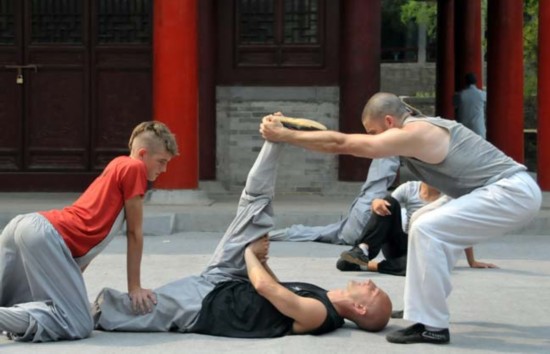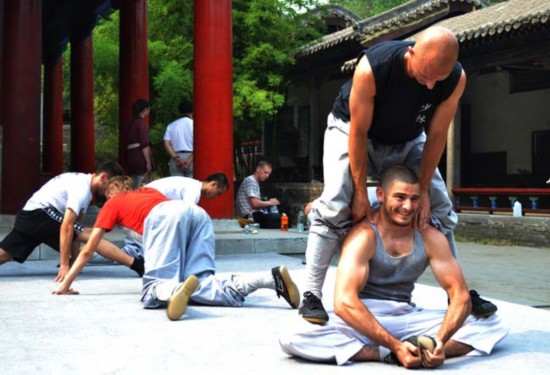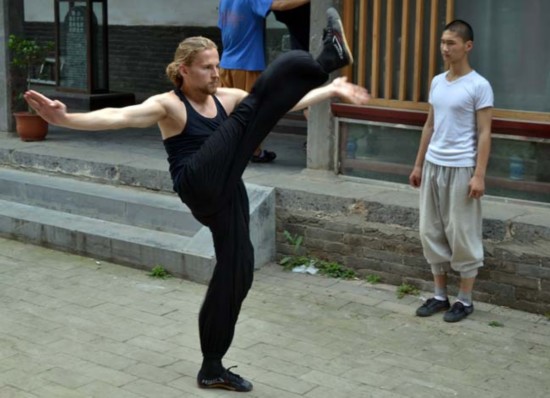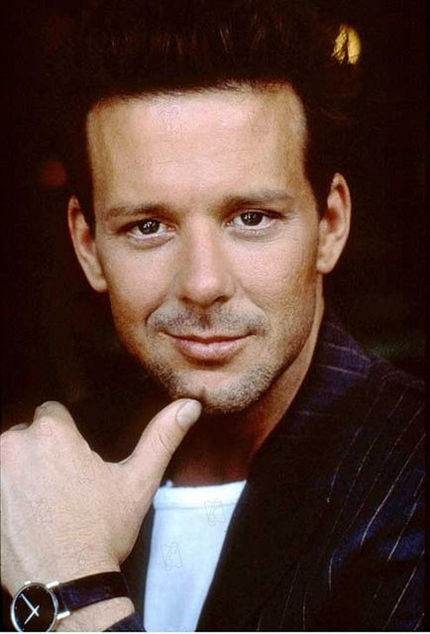Shaolin: Fists of fame
(China Daily) 09:17, July 28, 2014

Canadian Cale Klesko stretches and warms up his muscles with help from his friends before a kung fu class in the 1,500-year-old Shaolin Temple in Henan province. ZHANG LEILONG / CHINA DAILY
Ancient temple riding a wave of global interest in its style of kung fu, report Hou Liqiang and Qi Xin in Dengfeng, Henan province.
University student Maxim Kojevnikoff is visiting Shaolin Temple for the fourth time.
He had planned to join his friends in Wutaishan Mountain in Shanxi province, but decided to return to the renowned 1,500-year-old temple in Dengfeng city of Henan province.
"For me, learning kung fu in Shaolin is like lying on the beach and enjoying the sunshine," the 22-year-old Kojevnikoff said.
"Every time I return to Moscow from Shaolin, I feel rejuvenated."
The journalism major at Russian State Social University teaches Shaolin kung fu at a martial arts center in Moscow. He is still deciding between a career in journalism and martial arts. But he is sure he wants to continue teaching kung fu part time after he graduates.
Kojevnikoff is one of more than 2,000 foreigners who head to Shaolin Temple every year to learn kung fu. The number of visitors usually peaks during the summer vacation.
"Many come as a group. There are more than 20 groups every summer," said the temple's abbot, Shi Yongxin.
"A lot more come in twos or threes. There are such foreigners almost every day."
The abbot said many of the visitors also learn kung fu in the training schools nearby.
The visitors cite many reasons for going to Shaolin. Kojevnikoff said he heard about the temple and fell in love with martial arts after his parents sent him for classes when he was a child. His teacher later took him to Shaolin.
Canadian Cale Klesko said he goes to Shaolin to practice kung fu and Chinese culture, as he is dealing with an increasing number of Chinese companies in his work as an engineer in management consulting.
Kung fu also helps him keep "a balance between the body and the mind", the 30-year-old said.
Virginia Suen from Hong Kong said she learns kung fu to strengthen her body.
"I feel I am in good spirits after practicing kung fu," the 42-year-old assistant in an investment company said.
Many of the visitors also said they developed an interest in kung fu after watching movies about Shaolin as children. These include the 1982 movie, The Shaolin Temple, starring Jet Li.
Since 2001, Damo, a center for martial arts studies established in Russia, has organized kung fu students to Shaolin Temple every year. Rogov Viaches Lav, the chairman of the center, said at least 300 people studying in the center have visited Shaolin. The 46-year-old also said the center has trained more than 1,000 people in Shaolin kung fu.
Authorized by Shaolin, the center is now building a Shaolin-style complex in Russia.
"There will be Buddhism halls, training rooms, meditation rooms and a healthcare center," he said.
The facility will be built in line with Chinese feng shui geomancy concepts, he said.
The Russian said he developed an interest in kung fu after watching Chinese martial arts movies as a boy.
"Kung fu does not solely belong to China. It belongs to the world. It offers us opportunities to know each other. We should thank kung fu," he said.
The Damo center in Russia is one of the dozens of overseas centers authorized by Shaolin. According to Wang Yumin of the foreign affairs office of Shaolin Temple, there are now more than 40 such centers worldwide.
Shi Yongxin said there are hundreds or even thousands of Shaolin centers around the world, if "unauthorized ones set up by Shaolin's disciples and students are included".
Going abroad
More Shaolin monks are also going overseas to take part in cultural exchanges.
"About 400 Shaolin monks go abroad every year," Shi Yongxin said.
"In these cultural exchanges, we usually organize sessions to pray for global peace, cultural exchange forums, photo exhibitions and kaogong, a kung fu contest," he said.
Other activities include the annual California Songshan Shaolin Temple Day, which has been held for 10 years, and the Shaolin Culture Festival, which was launched in 2012 in Europe.
Shi Yanjia, a kung fu master at Shaolin Temple, began to take part in overseas activities in 2000 and has been to more than 10 countries.
"It's common to see some kung fu master going abroad for more than five times a year," the 32-year-old said.
Shi Yanjia is now able to carry on simple conversations with foreigners.
"I can manage simple exchanges in English," he said.
There are also English classes in the temple for monks once a week.

Cale Klesko, a Canadian citizen, helps his friend warm up before a kung fu session in Shaolin Temple on July 3.

Russian kung fu practitioner Maxim Kojevnikoff warms up in Shaolin Temple on July 3. (PHOTOS BY HOU LIQIANG / CHINA DAILY)
"No matter where you go, there are translators. But for simple daily expression, the monks can manage on their own," said Shi Yongxin.
"Shaolin Temple has emphasized exchanges with different cultures in its 1,500 years and held on to the belief that only communication can result in development," he said.
Liu Yi, deputy dean of the physical culture institute at Hubei University, said people can learn Shaolin kung fu in many training schools, but the temple is the most attractive place for foreigners and visitors because of the culture it represents.
"In Shaolin Temple, kung fu is combined with Chan Buddhism. It includes many aspects of traditional Chinese culture, such as having a strong sense of justice and being ready to help the weak," Liu said.
Many foreigners go to Shaolin not to learn kung fu to fight or defend themselves, but to learn more about these aspects of traditional Chinese culture, Liu said.
Hong Hao, head of the department of physical education at Henan University, said that Shaolin kung fu's combination with Chan Buddhism, which emphasizes meditation, can also make it popular in the West.
Shaolin kung fu can help people in the West who suffer from the fast pace of a competitive society by taking it slow to contemplate life and the value of their existence, he said.
Practicing the martial art can also help foreigners understand Chinese culture better through body language and physical expressions, Hong said.
But the temple needs to continue improving itself, he said. Many people teach its kung fu but there is no uniform standard. That may hinder its popularization, he said.
There are also no specialized teachers of the martial art. The monks are good at kung fu but they might not know how to teach it systematically. The temple also needs to pay more attention to the theoretical study of kung fu, he said.





 Reply With Quote
Reply With Quote



















